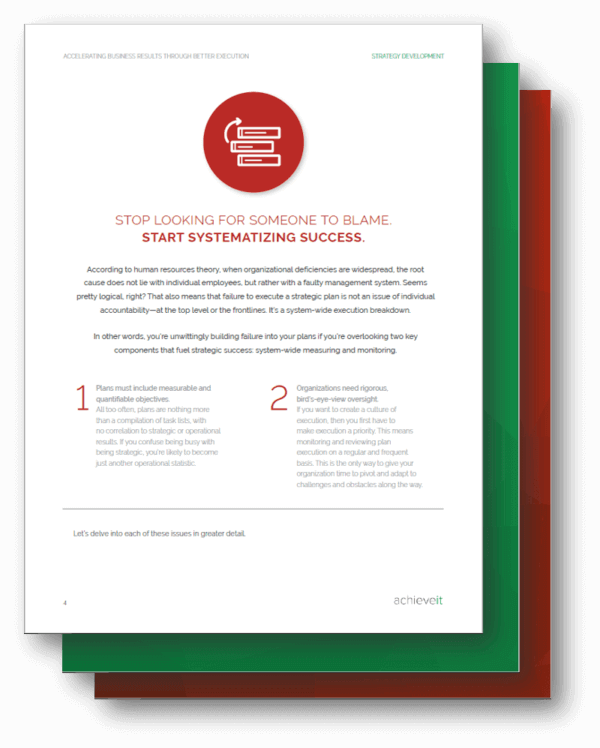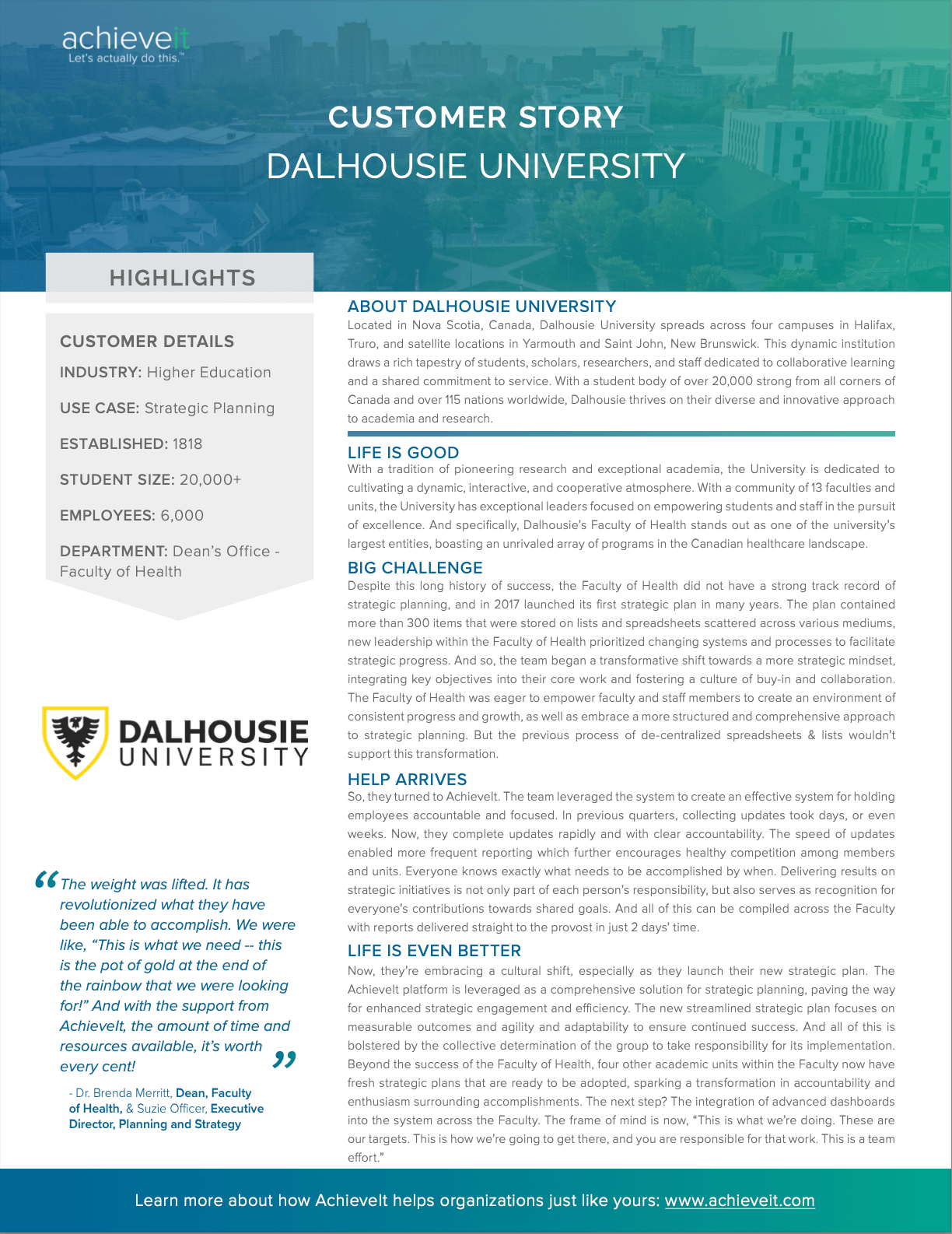Here are a couple of scenarios you’re likely to be familiar with:
Scenario 1: Your organization is full of people who do their jobs, but they don’t really understand why they’re doing it. They don’t see the bigger picture. They do what they’re told and may focus on individual goals but not the company’s larger goals.
Scenario 2: Your organization communicates the strategic plan to the team. Goals and objectives are shared for all to see. Your team might have memorized your mission statement, but they don’t really know how it all ties into what they’re doing.
The first example has no plan whatsoever. The second example includes a communications plan, but it’s not doing what it’s meant to do — effectively communicate the “why” of your plan and “how” each individual is connected to its success. So what do you do?
Jonathan Morgan, VP of Revenue Operations and Head of Marketing at AchieveIt, says that an effective communications plan “talks about your plan throughout its duration. It’s not just ‘how we’re doing’ but also reinforcing what we’re doing.”
After all, any marketer will tell you that people need to be presented with your messaging at least seven times before they give you their trust. The same can be said for your internal communications plan. You need to ensure that you’re communicating your strategy often and in an effective way so that your team internalizes your goals and objectives.
The two pillars of an effective internal communications plan
In order for your internal communications plan to be a success, it must achieve two things: understanding and communication.
1. Employees understand the company’s goals
First, you need to make sure that the people doing the work actually understand what’s important to the organization and that they’re an integral part of achieving the company’s goals. The entire company needs to fully understand what we’re doing and why we’re doing it. This shift from “the company” to “we” helps create a sense of ownership, engagement, and accountability.
2. Everyone communicates about those goals regularly
For your team to understand and get on board with the plan, you need to have regular conversations with them about your goals. Change management theory suggests that people have a tendency to “hold their breath” when presented with something new. They do this as a form of resistance to change, hoping that it will go away if ignored.
To avoid this situation in your strategic planning and execution, you need to keep talking about your plan. Make it clear that it is an integral part of the company and your team’s role in it. “So by talking about it periodically, you ensure that people not only understand it but that they align with and buy into it as well,” says Jonathan. “It’s not about putting a banner in the lobby or having everyone print it out to hang on their desk or their cubicle. It’s actually talking about it.”
FREE RESOURCE
Accelerate Business Results Through Better Strategy Execution
Download this guide to understand the key components of effective plan review and monitoring, while creating measurable and quantifiable objectives.

Internal communications plan best practices
Organizations like local government entities create communications plans for their target audiences. An internal communications plan might not need to be as granular as a public-facing strategy, but many of the best practices still apply.
Collaborate to establish your goals
To start, the strategic leadership team must identify what the organization needs to achieve through its plan. When identifying these goals, the “right people” should be involved in order to obtain their insights. These people are essentially anyone on the ground closest to the project who has firsthand experience with it.
If the goals identified are done so with the entire organization in mind, it will make it easier for the members of that organization to take them on board.
Define how to communicate across your internal audiences
Internal communication includes different people who fit into a variety of categories or audiences. The topics discussed and the level of detail will vary between board members and your frontline employees.
Start by identifying who these audiences are and then the different levels of details that need to be communicated to each of them. The channels used to communicate with each audience might be different as well. For your board members, it might be better to opt for in-person meetings, while frontline workers are best reached directly through your plan management software.
Identify the frequency of communication
As we’ve already discussed, communicating your goals frequently is an important part of the internal communications process. The message needs to be communicated enough so that it is internalized into your team’s way of working. Maybe you communicate major initiatives to executives via a weekly update and to all employees at a quarterly all-hands meeting.
Document and record your internal communications strategy
Once you have decided on all of the steps above, it’s time to create your internal communications strategy. You should keep a record of everything, from outlining your goals to the steps taken to communicate them.
This document should be readily available to all of your internal and external stakeholders.
Bonus: Use the right tools to help you communicate effectively
Your integrated plan management platform is there to facilitate your internal communications strategy — particularly when it comes to maintaining open lines of communication across the organization.
It automates planning and processes that, in turn, make it easier to visualize and communicate how things are progressing. Equipped with this information, internal communicators can create different types of dashboards and information that will be shared with different audiences.
It also makes meetings more productive. Strategy teams have regular check-in meetings, and very often, a lot of time is wasted collecting status updates on the spot. Integrated plan management solutions send reminders to team members to provide updates on the system. This means that when it’s time to sit down for a meeting, teams can spend more time discussing solutions rather than trying to identify what the issues are in the first place.
FREE RESOURCE
Dalhousie University Customer Story
Read this customer story to better understand how a university Faculty unlocked the key to strategic planning efficiency with AchieveIt.

How Dalhousie University harnessed a culture of accountability and strategy buy-in
When Dalhousie University launched their strategic plan in 2017, it spanned over 300 items stored across spreadsheets and lists across various mediums. In response to this, Dalhousie’s Faculty of Health sought to streamline their systems and strategic processes.
They were eager to earn the buy-in of all their faculty and staff members. But it quickly became clear that it was going to be impossible to do as the information lived in a decentralized web of spreadsheets and lists. They turned to AchieveIt to build an effective system that holds employees accountable and keeps them focused on the bigger picture.
Prior to AchieveIt, it took the faculty days, if not weeks, to collect status updates. Now, they are able to collect updates that highlight everyone’s role in achieving shared goals in just two days. Strategies that they have launched since then are embedded in achieving measurable outcomes and ensuring continued success.
Find out how Dalhousie University used AchieveIt to unlock the key to strategic planning efficiency.



